Every State's COVID Numbers in Context, October Edition
This is part of an ongoing monthly series in which I try to look at every state and how they are doing in regards to COVID positives and deaths.
For details to your state, feel free to skip around through this piece:
Midwest (Iowa, Illinois, Indiana, Michigan, Minnesota, Missouri, Ohio, Wisconsin)
Mountain States (Colorado, Idaho, Nevada, Utah, Wyoming)
Northeast States (Connecticut, DC, Delaware, Massachusetts, Maryland, New Jersey, New York, Rhode Island, Pennsylvania)
Southern Border (Alabama, Arizona, California, Florida, Louisiana, Mississippi, New Mexico, Texas)
Mid-South (Arkansas, Georgia, Kentucky, North Carolina, South Carolina, Tennessee, Virginia, West Virginia)
Plain States (Kansas, Montana, North Dakota, Nebraska, Oklahoma, South Dakota)
West Coast (Washington, Oregon, California)
Upper Northeast + Alaska & Hawaii (Vermont, New Hampshire, Maine, Alaska, Hawaii)
Summary
Disney Shorts: The Little House
Midwest
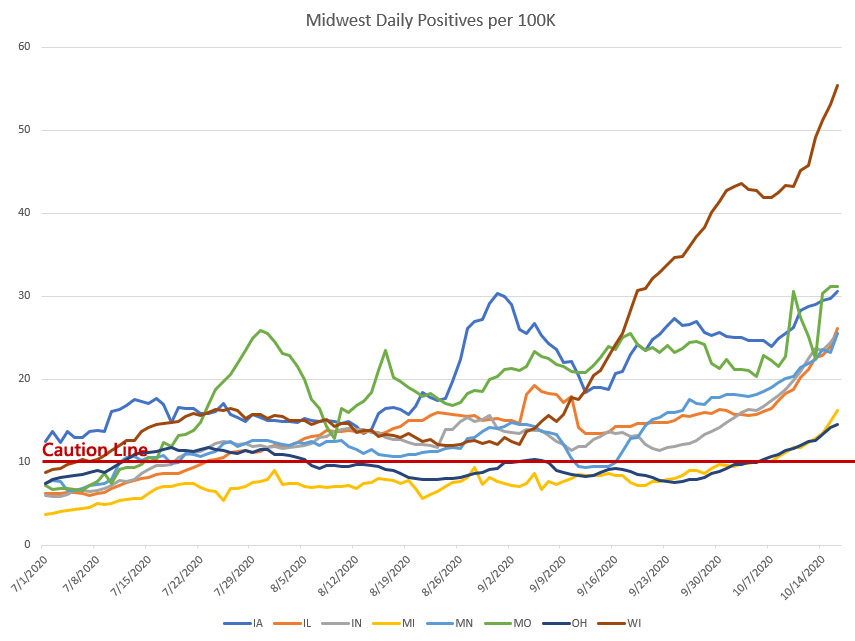
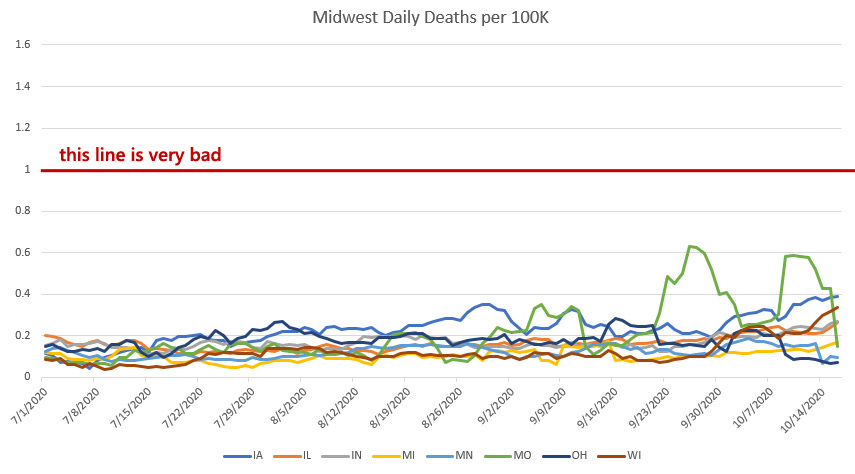
A lot of people have been talking about outbreaks in the Midwest and it is certainly disheartening to see Wisconsin’s numbers look like this a month later. Typically, a surge like this will last 8-10 weeks, so we should hope to see it peaking in the next week or two, but the damage is largely done and we’ll almost certainly see deaths rising as the reporting comes in over the next month or so.
The rest of the Midwest is not great either. While Iowa and Missouri have the most cases at the moment, we’re seeing an upward slope from all the midwest states. Most discouraging is that it looks like Michigan and Illinois may not be spared by this surge. Given how hard they were hit in the first wave, there had been some reason to hope they might avoid a subsequent wave, but hope seems thinner with the passing weeks.
Mountain States


At the beginning of this crisis, Colorado was the only mountain state that really got hit by this. Since that time, it has been consistently one of the best “performing” states in the mountain region. But all the mountain states are seeing cases rise in about the same pattern with Colorado trailing about 3-4 weeks behind the rest of the region. (Incidentally, this is something of a reinforcement of the idea that weather patterns driving people indoors has more to do with COVID surges than anything else.)
We haven’t seen deaths surging, but these cases are high enough that we expect to see that in the next 4-6 weeks.
Northeast States
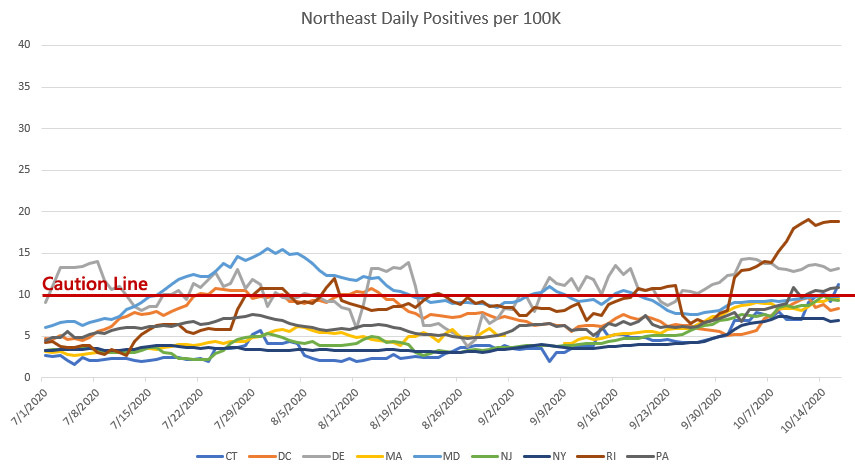

With the exception of Rhode Island, positives and deaths still remain low in the Northeast, although they have roughly doubled in the last month, which is not ideal. Still, many states have been able to keep positives around the caution line for months without a dangerous outbreak or a surge in deaths and so we’re going to hope that this is the case in the Northeast right now.
This will be the region we cross our fingers on and hope that there won’t be a threatening surge this next month. So far, I think these numbers aren’t terribly frightening.
Southern Border


There’s good and bad news in the southern border (sunbelt) states. Positives have mostly declined over the last month except for in New Mexico, the only state that has not yet had a major surge. There has been some uneven uptick in some states (Mississippi, Arizona), but at the moment it looks like this we could very easily be in the valley where positives will wander between 10-20 cases per 100K until there is another surge. This is higher than we would prefer, but if deaths are still sloping downward, it’s not terrible.
Mid-South


The mid South has always been kind of all over the map on COVID. What we see now is Georgia recovering from their summer surge the best while North and South Carolina are still working to keep cases under 20. Arkansas is currently having a difficult time with high rates of both cases and deaths and the surge in Tennessee in deeply concerning as well.
I don’t think there is enough of a trend in Virginia or West Virginia to make a declaration that they are in trouble. Both states have managed fairly well so far and, while their case counts are up a bit, they aren’t at a frightening level.
Plain States
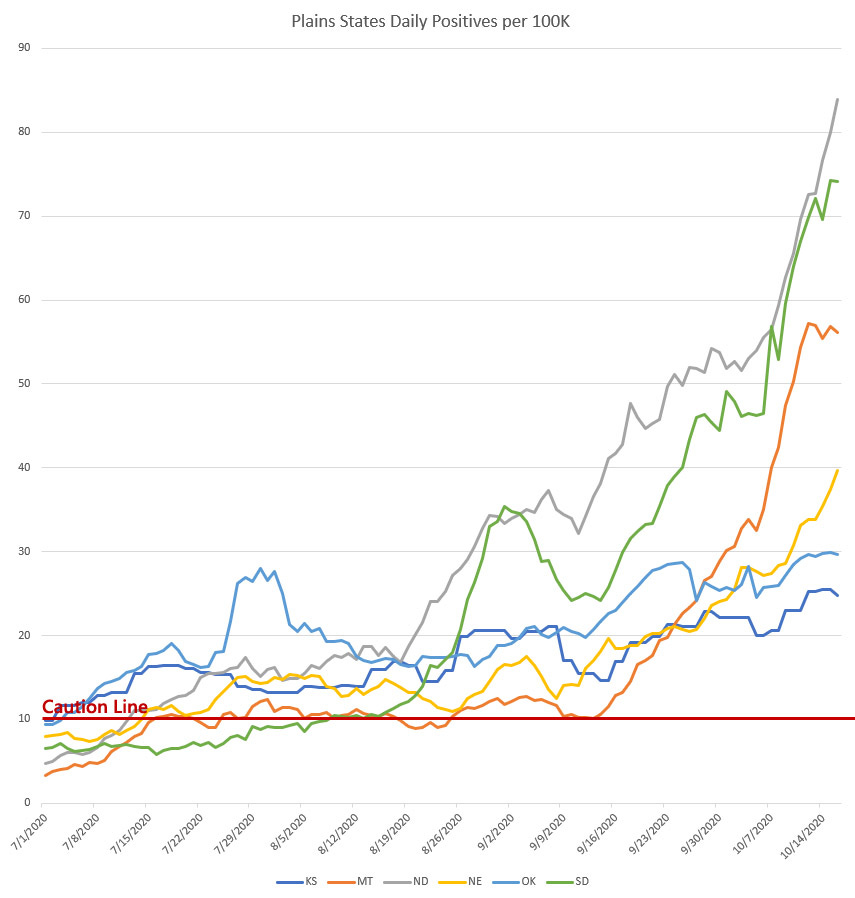
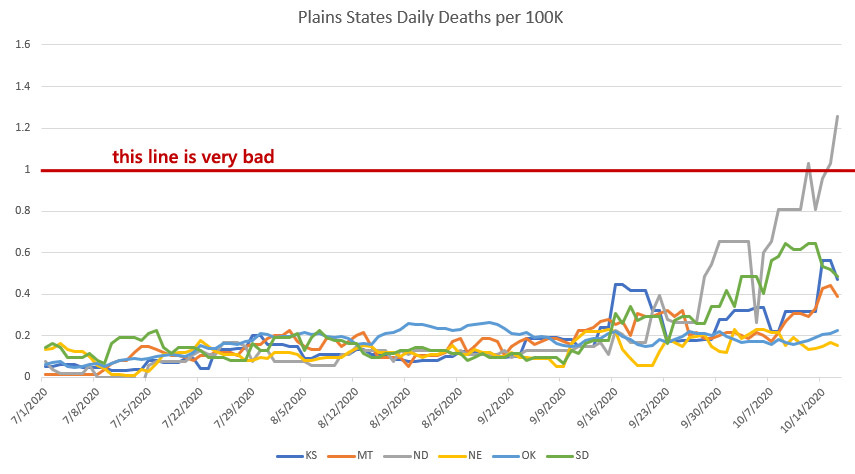
This I did not expect.
The outbreak in North Dakota, South Dakota, and Montana is so severe I had to create a new chart size. And this happened super-fast. This time last month, Montana was the lowest of the plains states in terms of COVID positives, after having wandered around the caution line for two months.
It looks like we’re at full-fledged COVID outbreak in the plains states and, while that hasn’t fully come out in the deaths metric (Montana, for instance is still fairly low), we should very much expect to see that rise in the November.
West Coast


The west coast seems to be largely unaffected. I don’t know why this is. We saw the surge in southern California during the summer but that has tapered off and both Oregon and Washington are still at fairly low levels of positive cases with high stability.
I can say from experience that the last week or two have seen some pretty miserable weather in Washington. With poor weather and very little sun, we’re likely to soon see if a COVID surge is inevitable or if long-term transmission can be kept down over a long term.
Upper Northeast + Alaska & Hawaii
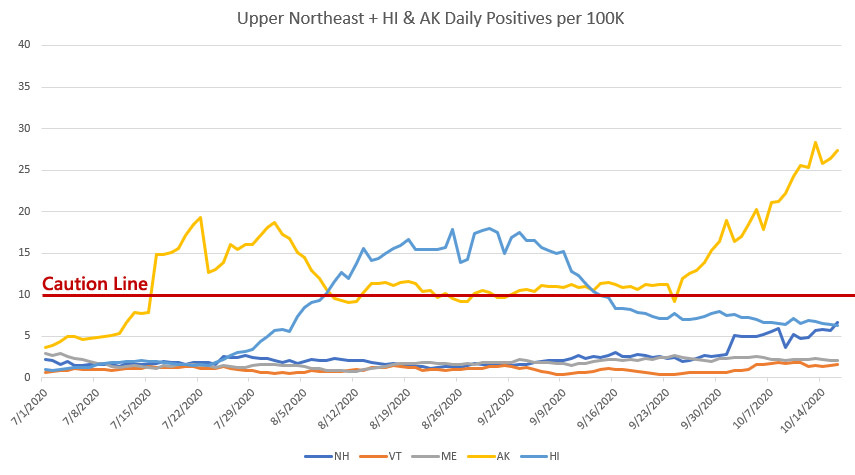
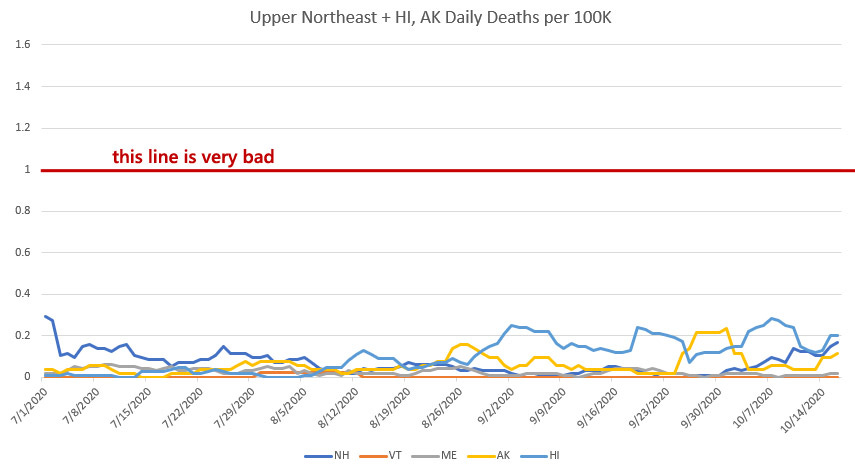
The upper Northeast remains fairly COVID-free. The surge in Alaska isn’t great, but Hawaii seems to be coming down from their summer surge with fairly low overall deaths, which is fantastic news.
Summary
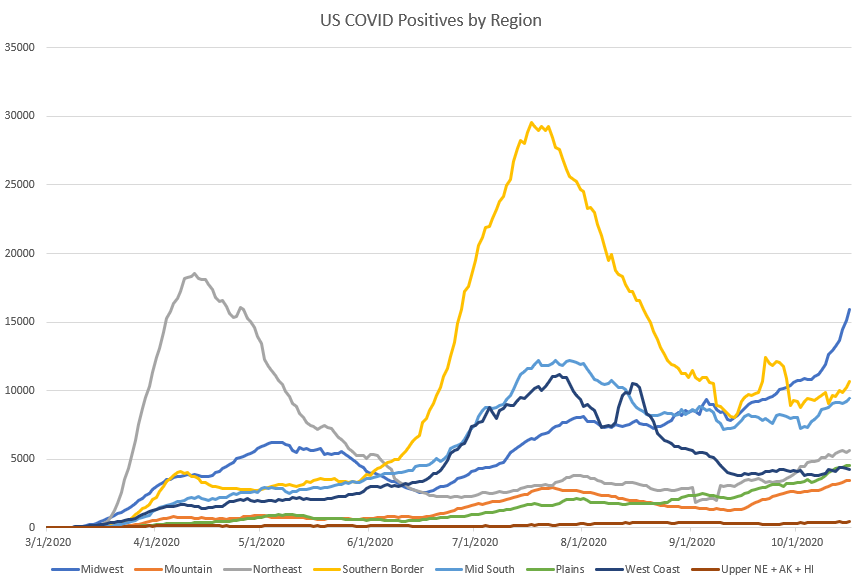
I added this chart as a way of seeing where in the US this current surge is taking place. Most of the increases are coming from the Midwest, but the fact that several regions are simultaneously seeing moderate increases tends to make the overall country-wide increase seem much steeper.
I think we are getting the first hints that the coming winter months may make it difficult to contain the virus, but nothing is written in stone and it could be that we can manage an elevated case plateau without seeing severe outbreaks (like the ones currently taking place in Europe).
It could be.
Disney Shorts: The Little House

Oh man, now I’m on a Bill Peet tear. I’ve heard talk about about this short but I don’t think I’ve ever seen it before. The animation style is looks a lot like the Peter Pan style & is narrated with the comforting folksy voice of Sterling Holloway (who voiced Winnie the Pooh among many many other Disney characters.
The story is an anti-progress, anti-urbanization tale about a little house that just wants to be lived in and useful. This is an extremely Disney-ish story, I can’t even imagine it as a Looney Tunes piece. It’s well made and cute, but not really in line with my sensibilities.

